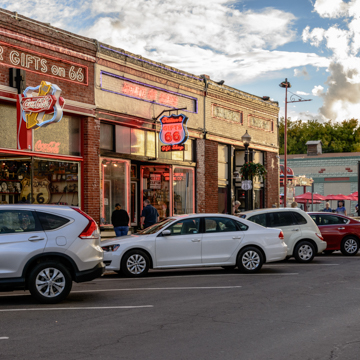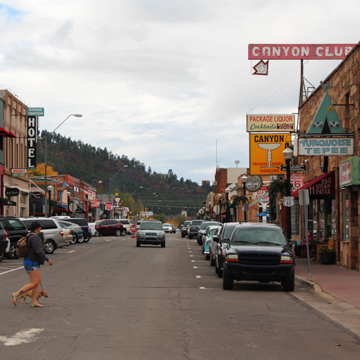The town of Williams in northern Arizona, situated some 32 miles west of Flagstaff, owes its founding to the railroad’s exploitation of the frontier west and it exists because of sheep and cattle ranching, mining, and logging and milling. But its existing built fabric is due to the rise of tourism in the early twentieth century. Williams served as the southern terminus for both rail and automobile access to the Grand Canyon (approximately 60 miles to the north). Though located on U.S. 66, it was the Atchison, Topeka and Santa Fe Railway’s efforts to brand Williams the “Gateway to the Grand Canyon” that provided economic prosperity in the first half of the twentieth century.
Named for a local trapper, the town sits at the base of the Bill Williams Mountain’s north face, at an elevation of 6,700 feet above sea level. This area, full of high meadows and ponderosa pine forests, was scarcely populated (but for sheep herds) before the arrival of the Atlantic and Pacific Railroad in the 1880s. When Charles T. Rogers, a Prescott merchant and cattle rancher, learned of the railroad’s interest in the region, he purchased John R. Vinton’s 160-acre ranch and established the town site in anticipation. Railroad construction commenced in 1881, and for a decade, Williams had the transitory appearance of a workers’ camp. Nonetheless, within two years, the boomtown boasted a post office, general stores, a drugstore, wholesale and liquor dealers, saloons, and a restaurant. The railroad continued to bring people, building materials, and business opportunities to the prosperous frontier town, which opened its first hotel (the Boyce Hotel) in 1892.
In 1898, local investors interested in ore extraction sought to build a railway spur northward, toward the Grand Canyon. The Santa Fe and Grand Canyon Railroad staked out a 60-mile Grand Canyon line with its southern terminus in Williams, but the company went bankrupt in 1901. The AT&SF Railway quickly acquired the property and finished the last 11-mile stretch to the south rim of the Grand Canyon. Recognizing the potential profitability of the tourist trade, the line was dedicated immediately and primarily to passenger service. Before long, the AT&SF’s entire east-west line was known as “The Grand Canyon Line.” As people from across the country and the globe traveled on the AT&SF to visit one of the world’s natural wonders, Williams benefited from the trade.
A series of fires (in 1901, 1903, and 1908) helped refine the town’s rough appearance, as wooden buildings were replaced by masonry, fireproof structures exhibiting various styles popular at the turn of the century. The town’s rough reputation was allayed when local authorities made gambling and prostitution illegal in 1907. As Williams became more welcoming to tourists, the AT&SF decided to expand its enterprise by developing the Fray Marcos Hotel and Depot (1908), retaining the Fred Harvey Company as manager. As concessionaires to the railway, the company operated restaurants known as Harvey Houses up and down the main line between Chicago and Los Angeles. Williams was the stop to access the “Titan of Chasms.”
Before the 1920s, trains dominated transcontinental travel in the United States, and the Grand Canyon Railway was the only reliable way for visitors to reach the colossal chasm. After the 1920s, improved roads, expanded automobile ownership, and competition from bus companies began to erode the railroads’ profits. In 1927, at the urging of the National Old Trails Association, the Bureau of Public Roads designated the federal highway of U.S. 66. In Arizona, the route was generally along the old pioneer Whipple wagon road; in Williams itself, U.S. 66 was a segment of Bill Williams Avenue through the center of town (which meant federal funds could be secured for its maintenance). By 1930, motor vehicles (also via Flagstaff) carried more tourists to the canyon’s south rim than the train.
As a railroad town, Williams might have been eclipsed by the rising popularity of private vehicular travel had it not been for the presence of U.S. 66. In town, what became the federal route was initially a muddy track later that was laid with cinders in 1921 and then paved in Portland cement in 1928 and 1932. With these improvements came increased traffic, and with traffic came new amenities such as gas stations, automotive garages, motels, souvenir shops, and diners, which popped up along the east side of town in the 1930s and 1940s. Although the Great Depression had affected Williams’ economy, its proximity to the canyon preserved a steady level of tourism. Train service to the canyon was temporarily halted through World War II, and although it was resumed after the war, the Grand Canyon Railway began a steady decline; succumbed to tourists’ preferences for cars, the railway ceased service in 1968 (it was revived in 1989). Before then, in 1960, the coast-to-coast rail line that had once ensured Williams’ relevance bypassed the town. In 1984, the highway did the same: the completion of I-40 around Williams, along with the decommissioning of U.S. 66, rendered the once heavily trafficked thoroughfare a much quieter, less crowded commercial street.
Williams’ built fabric corresponds with these two transportation-related booms in tourism. The town’s historic commercial district is composed of small scale (one- and two-story) buildings from the late nineteenth to mid-twentieth centuries. The six-block area includes Saloon Row, parts of the Route 66 commercial zone, and the Fray Marcos nexus of the AT&SF Railway. Native flagstone, locally quarried dacite, concrete, and brick are the dominant building materials (most of the town’s early wooden architecture succumbed to fire). Across hotels, bars, civic buildings, and dwellings, styles range from Romanesque Revival to Mission Revival and Streamline Moderne.
In 1984, the Williams Historic Business District was nominated to the National Register of Historic Places, including portions of the original townsite, the Scott Addition, and buildings associated with the AT&SF Railway. The overall character of the Williams Historic Business District reflects the town’s tourist-driven economy at key points in the twentieth century. Tourism remains Williams’ economic engine today and preservation of the town’s built fabric from circa 1890 to circa 1940 has been key to its survival as a destination for travelers nostalgic for what is now Historic Route 66.
References
Cleeland, Terri A., “Urban Route 66: Williams,” Coconino County, Arizona. National Register of Historic Places Registration Form, 1988. National Park Service, U.S. Department of the Interior, Washington, D.C.
Hoffman, Charles A., “Williams Historic Business District,” Coconino County, Arizona. National Register of Historic Places Registration Form, 1983. National Park Service, U.S. Department of the Interior, Washington, D.C.
Richmond, Al, “Grand Canyon Railway,” Coconino County, Arizona. National Register of Historic Places Registration Form, 1998. National Park Service, U.S. Department of the Interior, Washington, D.C.



















